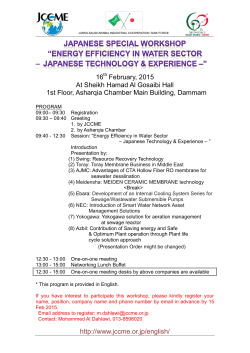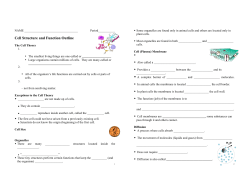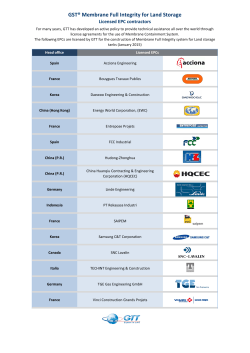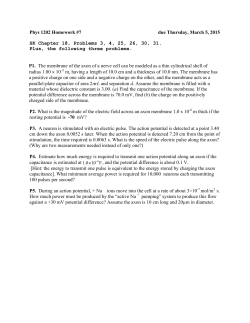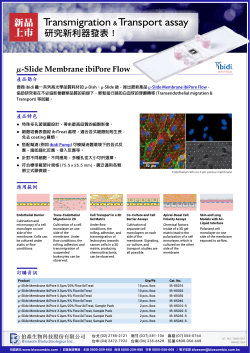
Actuation of Flexoelectric Membranes in Viscoelastic Fluids with
Proceedings of the 2nd International Conference on Fluid Flow, Heat and Mass Transfer
Ottawa, Ontario, Canada, April 30 – May 1, 2015
Paper No. 151
Actuation of Flexoelectric Membranes in Viscoelastic Fluids
with Application to Outer Hair Cells
Edtson Emilio Herrera Valencia
Faculty of Higher Education Zaragoza, National Autonomous University of Mexico, Department of
Chemical Engineering,
Campus I: Av Guelatao No. 66 Col. Ejercito de Oriente, Iztapalapa, C. P. 09230,
Mexico City, Mexico
edtson_ed@hotmail.com
Abstract- Liquid crystal flexoelectric actuation uses an imposed electric field to create membrane bending and it is
used by the Outer Hair Cells (OHC) located in the inner ear, whose role is to amplify sound through generation of
mechanical power. Oscillations in the OHC membranes create periodic viscoelastic flows in the contacting fluid
media. A key objective of this work on flexoelectric actuation relevant to OHC is to find the relations and impact of
the electro-mechanical properties of the membrane, the rheological properties of the viscoelastic media, and the
frequency response of the generated mechanical power output. The model developed and used in this work is based
on the integration of: (i) the flexoelectric membrane shape equation applied to a circular membrane attached to the
inner surface of a circular capillary, and (ii) the coupled capillary flow of contacting viscoelastic phases, such that
the membrane flexoelectric oscillations drive periodic viscoelastic capillary flows, as in OHCs. By applying the
Fourier transform formalism to the governing equation an analytical expression for the transfer function, associated
to the curvature and electrical field, power dissipation elastic storage were found. The integrated
flexoelectric/viscoelastic model and the novel findings contribute to the ongoing quest for a fundamental
understanding of the functioning of outer hair cells (OHC), especially on the role of membrane deformation in
delivering mechanical power through electromotility and its frequency-dependent power conversion efficiency.
Keywords: Rheology, Transport-Phenomena, Flexoelectric membrane actuation, Flexoelectric-driven
viscoelastic capillary flow, rheological transfer function, Outer hair cells.
1. Introduction
In Nature and physiology, biological liquid crystals play significant roles as multifunctional materials
(Abou-Dakka et al. 2012). This paper presents theory and simulation of a physiological actuator device
whose functioning hinges on unique electro-mechanical properties of mesophases and that provides an
example of responsive self-organized materials. The functioning of Outer Hair Cells (OHC) in the inner
ear involves electric-field driven periodic curvature oscillations of liquid crystal (LC) elastic membranes
that impart momentum and flow to the contacting viscoelastic fluids; the electric field actuation of the
liquid crystal membrane is known as flexoelectricity (Abou-Dakka et al. 2012; Herrera-Valencia, Rey
2014). The key role of OHC is sound amplification in the presence of viscous dissipation and elastic
storage (Abou-Dakka et al. 2012; Herrera-Valencia, Rey 2014). Hence, the full description and
understanding of OHC functioning has to include the frequency response of flexoelectric membranes
embedded in viscous and viscoelastic media due to an oscillating E field (Abou-Dakka et al. 2012;
Herrera-Valencia, Rey 2014). The field of flexoelectric membranes was pioneered and developed by
Petrov and co-workers (Abou-Dakka et al. 2012; Herrera-Valencia, Rey 2014). The generic and key
features of the electrical to mechanical energy conversion system in OHCs). The input oscillating E field,
through the electromechanical flexoelectric effect, produces curvature oscillations in the elastic
membrane that forms the OHC (Abou-Dakka et al. 2012; Herrera-Valencia, Rey 2014) and that is
surrounded by viscoelastic media. In turn, the oscillating elastic membrane displaces the contacting
151-1
viscoelastic liquids through the mechanical viscoelasto-elasticity effect (Abou-Dakka et al. 2012; HerreraValencia, Rey 2014). The combined effect that allows the electro-mechanical energy conversion is based
on the integration of flexoelectric effect (E field imposed on flexoelectric membrane) and the mechanical
effect (membrane elasticity plus viscoelastic bulk fluid flow) (Abou-Dakka et al. 2012; Herrera-Valencia,
Rey A.D. 2014). The two key issues in this energy conversion device are:
(i) How much power P is eventually delivered to the contacting viscoelastic fluids from the
imposed oscillating electric field E and how much stored membrane elastic energy Em is
required to deliver that power, and
(ii) Under which material conditions, a well-localized resonant power peak is found (in the
spectrum of P), as physiologically required.
As expected, the issues (i) and (ii) identified above depend on (a) the E-frequency as well as on
(b) the material properties of the bio-device components discussed below (Abou-Dakka et al. 2012;
Herrera-Valencia, Rey 2014).
1.1. Frequency response
The intensity of the linear momentum transfer from the oscillating membrane to the contacting
viscoelastic fluids depends on the imposed frequency (Abou-Dakka et al. 2012; Herrera-Valencia, Rey
A.D. 2014). Hence frequency-dependent viscoelasticity is an essential ingredient of this important
biological LC electro-mechanical oscillator (Abou-Dakka et al. 2012; Herrera-Valencia, Rey A.D. 2014).
Viscoelasticity is an important frequency-dependent property of synthetic and biological materials and
processes (Abou-Dakka et al. 2012; Herrera-Valencia, Rey 2014). Biological systems respond differently
to inputs of different frequencies (Abou-Dakka et al. 2012; Herrera-Valencia, Rey A.D. 2014). Some
systems may amplify components of certain frequencies, and attenuate components of other frequencies
(Abou-Dakka et al. 2012; Herrera-Valencia, Rey 2014) , and this property is crucial to understand the
processes that control the functioning of OHCs (Abou-Dakka et al. 2012; Herrera-Valencia, Rey A.D.
2014) and hearing processes (Abou-Dakka et al. 2012; Herrera-Valencia, Rey 2014). The frequency
response (Abou-Dakka et al. 2012; Herrera-Valencia, Rey 2014) is the relationship between the system
input and output in the Fourier domain.
1. 2. Materials
Nematic liquid crystals (NLC) are multifunctional self-organizing viscoelastic anisotropic materials
whose orientational order responds to external flow, electromagnetic, chemical, optical and surface fields
(Petrov 2014; Rey 2005, 2006a-c, 2008a,b) the orientational order is defined by the director n and the
elastic distortions by director gradients n (Petrov 2014; Rey 2005, 2006a-c, 2008a,b). A distinguishing
and novel property of nematics is flexoelectricity (Petrov 2014; Rey 2005, 2006a-c, 2008a, b) which
describes the coupling between orientational gradients and electric polarization, such that an applied
electric field creates orientational distortions and distortions create macroscopic polarization (Petrov
2014; Rey 2005, 2006a-c, 2008a,b). Thin layers and biological membranes behave like liquid crystals,
membranes should also exhibit flexoelectricity or couplings between polarization and bending
(Abou-Dakka et al. 2012; Herrera-Valencia, Rey 2014, Rey 2005, 2006a-c, 2008a, b). Figure 1
shows a schematic of flexoelectric polarization in rod-like and banana-like molecules and the
corresponding membrane flexoelectric polarization; as noted above the physics and modeling is affected
by identifying the director field n with the membrane normal k.
As a partial result, both the direct and converse membrane flexoelectric effects are sensor-actuator
properties when membrane curvature and polarization are coupled as in nematic liquid crystals.
Membrane flexoelectricity due to its inherent sensor-actuator capabilities is an area of current interest in
soft matter materials (Abou-Dakka et al. 2012; Herrera-Valencia, Rey 2014). Over the years, much
literature has dealt with the problem of measuring flexoelectric coefficients in various liquid crystals
151-2
(Abou-Dakka et al. 2012; Herrera-Valencia, Rey 2014). For typical LC membranes, these coefficients
range from 3-20 pC/m, but recent experiments have reported flexoelectricity coefficients of up to 35
nC/m in bent-core liquid crystals (Abou-Dakka et al. 2012; Herrera-Valencia, Rey 2014). Such large bend
coefficients make bent-core liquid crystals practical materials for mechano-electric transduction (AbouDakka et al. 2012; Herrera-Valencia, Rey 2014).
The specific objectives of this paper are:
(1) To derive a high order dynamic linear model for a flexoelectric membrane attached to a
capillary tube that contains viscoelastic liquids and is subjected to a fluctuating small
amplitude electric fields of arbitrary frequency;
(2) To compute the frequency response of the electromechanical device, taking into account the
viscoelastic nature of the contacting fluids;
(3) To use the modelling results to characterize the role of membrane flexoelectricity and
contacting fluid viscoelasticity on the transfer function of the device;
(a)
(b)
Fig. 1. (a) Flexoelectricity in rod-like and banana-shaped nematic liquid crystals due to slay and bend deformations
of the director n. (b) Flexoelectricity in biological membranes due to bending curvature described by surface
gradients of the unit normal k. The correspondence between nematic flexoelectricity and membrane flexoelectricity
is obtained when the director n is identified with the membrane unit normal k. Adapted from Abou-Dakka et al.
(2012).
As a partial result, both the direct and converse membrane flexoelectric effects are sensor-actuator
properties when membrane curvature and polarization are coupled as in nematic liquid crystals.
Membrane flexoelectricity due to its inherent sensor-actuator capabilities is an area of current interest in
soft matter materials (Abou-Dakka et al. 2012; Herrera-Valencia, Rey 2014). Over the years, much
literature has dealt with the problem of measuring flexoelectric coefficients in various liquid crystals
(Abou-Dakka et al. 2012; Herrera-Valencia, Rey 2014). For typical LC membranes, these coefficients
range from 3-20 pC/m, but recent experiments have reported flexoelectricity coefficients of up to 35
nC/m in bent-core liquid crystals (Abou-Dakka et al. 2012; Herrera-Valencia, Rey 2014). Such large bend
coefficients make bent-core liquid crystals practical materials for mechano-electric transduction (AbouDakka et al. 2012; Herrera-Valencia, Rey 2014).
The specific objectives of this paper are:
(4) To derive a high order dynamic linear model for a flexoelectric membrane attached to a
capillary tube that contains viscoelastic liquids and is subjected to a fluctuating small
amplitude electric fields of arbitrary frequency;
(5) To compute the frequency response of the electromechanical device, taking into account the
viscoelastic nature of the contacting fluids;
(6) To use the modelling results to characterize the role of membrane flexoelectricity and
contacting fluid viscoelasticity on the transfer function of the device;
151-3
2. Physical Problem
In this work, we model the system in the frequency domain, include momentum inertia, and develop
a generic approach that can be used in the future with any viscoelastic constitutive equation, as required
by experimental results (Abou-Dakka et al.2012; Herrera-Valencia & Rey 2014). The physical set-up and
geometry of the flexoelectric membrane tethered to a capillary tube containing two viscoelastic fluids is
depicted in Figure 2.
Fig. 2. Schematic of the geometry and operation of flexoelectric mechanics defined in Figure 2, in a capillary
geometry of radius a and axial length L.
The input E field distorts the initially flat circular membrane into a spherical cap of radius R and
height h . The flexoelectric actuation creates a capillary viscoelastic flow in the contacting top (t) and
bottom (b) fluids of viscosities t , b , relaxation times t , b and fluid densities t , b
respectively. Adapted from Abou-Dakka et al. (2012)
A capillary tube of radius “a” contains an edge-fixed flexoelectric membrane located at z = 0. Above
and below the membrane there are two viscoelastic fluids with column heights z = L, viscosities ηb ,ηt
relaxation times λ b ,λ t and densities ρ b ,ρ t respectively. The pressure at the top of the upper layer
and at the bottom of the lower layers are equal to a constant, i.e. pt ξ 2L,t pb ξ 0,t p0 . By
imposing a fluctuating electrical field E (t) the membrane oscillates and displaces the upper and lower
incompressible viscoelastic fluids; we emphasize that the Poiseuille flow is only generated by the
flexoelectric effect of the membrane caused by the imposed E t field (Rey 2005, 2006a-c, 2008a,b;
Abou-Dakka et al. 2012; Herrera-Valencia & Rey 2014). The membrane deformation is described by a
spherical dome of height h and radius R (Rey 2008a-c).
3. Electro-rheological Model
Here, we show that in the inertia-less regime the model can be mapped into a standard mechanical
spring-dashpot model (Herrera-Valencia & Rey 2014). By neglecting the momentum inertia, and
characterizing the viscoelastic media with two Maxwell fluids, the following second order linear
differential equation was obtained by Abou-Dakka et al. (2012) and generalized by Herrera-Valencia &
Rey (2014).
151-4
*
d2
d
d2 d
*
* 1-k
*
b
k,
λ
λ
b
k,
1
t
a
kb
k,
λ
λ
1 t
t
b
t
b
2
2
1
0
η
dt 2
dt
k
dt 2 dt
(1)
Where 1-k/k is the inverse of the dimensionless effective membrane tension, i.e. 1-k/k = 1/M . The
curvature viscous b1 k, η and curvature inertial b2 k, λ t λ b material functions are defined by:
*
*
1 k
b1* k, η 1+
Ση
k
, b*2 k, λ t λ b
λt λb
k
(2a, b)
3. 1. Dimensionless numbers
The governing Equation (4) contains five dimensionless numbers t b , Σ η , k, De,a 0 , which are
associated with the following mechanisms: (i) Memory
*
:
t
product of the viscoelastic
b
dimensionless times t , and b , it obeys, t b 1 and defines the elastic asymmetry of the fluids.
When t b 1 (highly asymmetric case) one of the fluids is nearly inelastic, and when
t b 1/ 4 (highly symmetric case) both fluids are equally elastic; (ii) Bulk Viscosity
Σ = η +η = G λ +G λ : total viscosity in the system, where the elastic dimensionless moduli
η
t
b
t
t
b
b
satisfy G t +G b 1 . The numerical value of this number is controlled by the product between the two
dimensionless Maxwell time numbers t b , Σ η =Σ η λ t λ b ; (iii) Elastic ratio k : dimensionless ratio
between the membrane and the total system elasticity : 0< k = 1 1/ M
1
1 . A floppy (soft) and stiff
(rigid) membrane corresponds to k<<1 and k 1 respectively. The elastic ratio, k = k M
is
determined by the dimensionless elastic membrane modulus; (iv-v). The Deborah De and flexoelectric
a *0 numbers given by:
De =
ti a
=
t ve
ρt ρb / G t + G b
λ t +λ b
;
a *0
cf E 0a/4L
M
(3a, b)
a *0 is the dimensionless conversion of electric to elastic energy or equivalently the static transfer
function at zero frequency (Abou-Dakka et al. 2012; Herrera-Valencia & Rey 2014).
3. 2. Response mode classification
To satisfy Equations (4-6), besides the restrictions noted above, the maxima and minima values of the
total dimensionless bulk-viscosity number Σ ηmin , Σ ηmax
must be bounded by the values of the Maxwell
relaxation times in the bottom and the top fluids. Under perfect symmetry (identical elasticity in top and
bottom fluids) λ t λ b =1/4 , and the total viscosity is fixed at Σηmax Σηmin 0.5 , while under nearly
151-5
total asymmetry
λ t λ b ε <<1 , the total viscosity can vary between Σηmax 1, Σηmin ε 1 .
According to the magnitudes of the three dimensionless numbers
, Σ ,k , the system
t b
η
(Equations 4-6) displays six distinct modes, summarized in Table I. These six modes arise since the
memory symmetry can be high (HS) or low (LS), the total viscosity high (HV), medium (MV) or low
(LV), and the membrane can be floppy (FM) or stiff (SM). For example, in Table I the third row mode
{LS, LV, FM} corresponds to low symmetry, low viscosity and floppy membrane. This effective mode
classification narrows down the parametric envelope of biological significance.
Table 1. Device response modes.
System’s Modes
λt λb
Ση Ση λ t λ b
I Low Symmetry, Low Viscosity, Floppy membrane {LS, LV,
FM}
ε
ε
II Low Symmetry, Low Viscosity, Stiff Membrane
{LS, LV, SM}
ε
ε
ε
1 ε
ε
1 ε
1
1/ 4
1/ 2
k << 1
1/ 4
1/ 2
1
III Low Symmetry, High Viscosity, Floppy Membrane {LS,
HV, FM}
IV Low Symmetry, High Viscosity, Stiff Membrane
{LS, HV, SM}
V High Symmetry, Intermediate Viscosity, Floppy Membrane
{HS, IV, FM}
VI High Symmetry, Intermediate Viscosity, Stiff Membrane
{HS, IV, SM}
k
k << 1
k ε
t b : memory, Σ η : viscosity, k: elasticity ratio,
1
k << 1
k ε
ε 104
The specific numerical values in Table I are selected as to be characteristic of each mode. The six
modes in Table I, can be represented by the vertices of a prismatic 3D material space shown in Figure 3,
spanned by fluid memory
, membrane elasticity k , and total fluid viscosity Σ . The front
t b
η
4
edge of the prism, defined by the line t b 10 , Σ η 1 , 0<k<1
151-6
Fig. 3. Prismatic material space for the six possible modes of Equations (1-3), shown in Table I. The vertical axis is
the memory of the fluids, the horizontal is the elasticity ratio k, and the axis into the page is the total viscosity of the
fluids. The six vertices correspond to the six modes in Table I.
4. Fluid Power Dissipation
E t, Exp iωt
The average power delivered to the viscoelastic fluids P by the oscillating membrane is the
period average of the product of the input force
(7), i.e., Im[F ω ] :
times the flow rate
t, 21 dH t, / dt and is proportional to imaginary part of the transfer function of Equation
D
1
P ω Re E t, ω Re t, ω Im FD ω
2
(4)
Notice that, in this particular case, It is used an analytical complex function (exponential function) to
describe the input force (electrical field), but it can be generalized with a stochastic function trough a
Fourier series (Herrera et al. 2009, 2010).
5. Numerical Results
Figure 4 shows the power dissipation as a function of the dimensionless frequency for the modes
{I, III, V}, without inertia (a) and the power dissipation as a function of the elastic ratio in the mode III.
Inertialess conditions generate a broader power peak only in mode III (large viscosity) since dissipative
modes persist with higher frequencies. These facts follows from the fact that the power is proportional to
the imaginary part of the transfer function (see Equation 10) and according to the asymptotic results of
Appendix C, only under finite inertia Im FD converges at large frequency to its static value. Hence
except for mode III, inertia-less conditions do not generate power pulses. The material properties used in
the simulation correspond to mode III {LS, HV, FM}. It is clear that the elastic ratio k plays an important
role in the amplitude, and affects the symmetry and frequency bandwidth of the resonance. As expected
more floppy membranes will result in higher dissipation as they store more energy.
151-7
(a)
Fig. 4. (a) Power dissipation
(b)
as a function of the dimensionless frequency for the mode {I, III, V} in the
P
cases where the inertial mechanisms are absent. (b) Power dissipation as a function of the elastic ratio k . The
material parameters used in the simulation correspond to mode III. Softer membrane generates more power
dissipation.
6. Conclusion
Membrane flexoelectricity is a novel electromechanical coupling effect that occurs in polarizable
media under geometric curvature (Petrov 2006). The sensor effect is performed by bending induced
electric polarization, whereas the converse actuation effect is performed by the membrane curvature
induced by an imposed electric field (Rey 2005, 2006a-c; 2008a,b). Membrane flexoelectricity is relevant
to the biological functioning of the Outer Hair Cells (OHC) which act as amplifiers to counteract viscous
dissipation through mechanic transduction and thus allowing hearing (Brownell 2007; Abou-Dakka et al.
2012; Herrera-Valencia & Rey 2014). The key challenge is to understand the coupling of oscillatory
flexoelectric actuation and the viscoelastic phenomena of the fluids that are in contact with the oscillating
membrane.An efficient method to describe membrane flexoelectricity is to use the liquid crystal analogy
that follows by identifying the director field of a nematic with the unit normal to the membrane (AbouDakka et al 2012; Herrera-Valencia 2014). A key parameter is the flexoelectric coefficient which for
biological membranes is of the order of 3-20 pC/m (Abou-Dakka et al 2012; Herrera-Valencia 2014).
In this paper we explored the dynamics of the actuation flexoelectric mode. An integrated dynamical
model for the average curvature of flexoelectric membranes oscillating in viscoelastic fluid media under
capillary confinement was formulated using a previously presented shape equation based on the liquid
crystal approach (de Gennes & Prost 1994; Petrov 2006; Rey 2005; 2006a-c; Rey 2008a,b). The
membrane curvature dynamics is given by a balance between the viscoelastic stress jump from the
contacting bulk liquids, the restoring membrane effective tension, and the driving flexoelectric force
(Abou-Dakka et al. 2012; Herrera-Valencia & Rey 2014). Using the flexoelectric shape equation in
conjunction with a viscoelastic capillary flow model for the contacting phases we obtained a new average
curvature dynamic equation (Abou-Dakka et al. 2012; Herrera Valencia & Rey 2014). Applying the
Fourier transform to the governing partial linear differential equation and using the relation between the
speed of the average curvature and volumetric flow, a relation between the average curvature and applied
electrical field was found (Abou-Dakka et al. 2012; Herrera Valencia & Rey 2014). The corresponding
dynamic, is a function of the asymmetry of the viscoelastic phases, total bulk viscosity and membrane
elasticity, through characteristic dimensionless numbers associated to each mechanisms (Abou-Dakka et
al. 2012; Herrera Valencia & Rey 2014). A thorough parametric study was performed to identify the
conditions that lead to the emergence of a power pulse (Abou-Dakka et al. 2012; Herrera Valencia & Rey
2014). It was found that, the inertial mechanisms play an important role in the resonance curves
associated to the power dissipation in the relevant modes {I, III, V}, which corresponds to the cases of a
low and high symmetry of the viscoelastic phases, low and sufficiently large total bulk viscosity and
151-8
small elastic ratio indicating that less elasticity is stored in the membrane (Abou-Dakka et al. 2012;
Herrera Valencia & Rey 2014).
An evaluation of the present model predictions based on power profile, indicates that the HelfrichFlexoelectric-Maxwell fluid model possess the necessary physics to qualitatively capture electromechanical power conversion (Brownell 1985; Petrov 2006; Rabbits et al. 2009)
The linear model presented here is only valid for electric fields of sufficiently small amplitude, high
dimensionless frequencies and small deformations. The present theory, model, and computations
contribute to the evolving fundamental understanding of biological shape actuation through
electromechanical couplings (Rey 2005; Rey 2006a-c; Rey 2008a-b; Abou-Dakka et al. 2012; HerreraValencia & Rey 2014).
Acknowledgements
EEHV gratefully acknowledges financial fellowship support from CONACYT-MEXICO
(Postdoctoral Grant 147870) and the Canada Government trough Foreign Affairs and international Trade
Canada (DFAIT).
References
Abou-Dakka, M., Herrera-Valencia, E.E. Rey, A.D. (2012). Linear oscillatory dynamics of flexoelectric
membranes embedded in viscoelastic media with applications to outer hair cells, J. Non-Newtonian
Fluid Mech., 185-186, 1-17.
Brownell, W.E. (1985). Evoked mechanical responses of isolated cochlear outer hair cells, Science, 227,
194-196.
de Gennes, P.G., Prost, J. (1994). The Physics of Liquid Crystals. Oxford, UK: Second Edition, Oxford
University Press.
Herrera-Valencia E.E., A. D. Rey (2014). Actuation of flexoelectric membranes in viscoelastic fluids
with applications to outer hair cells, Phil. Trans. R. Soc. A., 372, 20130369/1-28.
Herrera, E.E., Calderas, F., Chavez, A.E., Manero, O., Mena, B. (2009). Effect of random longitudinal
vibrations pipe on the Poiseuille flow of a complex liquid, Rheol. Acta, 48, 779-800.
Herrera, E.E., Calderas, F., Chavez, A.E., Manero, O. (2010). Study on the pulsating flow of worm-like
micellar solution, J. Non-Newtonian Fluid Mech., 165 174-183.
Petrov, A. G. (2006). Electricity and mechanics of bio-membrane systems: flexoelectricity in living
membranes, Anal. Chim. Acta, 568, 70-83.
Rabbits, R.D., Clifford, S., Breneman, K.D., Farrell, B., Brownell, W.E. (2009). Power efficiency of
outer hair cell somatic electromotility, Plos Comput. Biol, 5, 1-14.
Rey, A.D. (2005) Mechanics of soft solids-liquid crystals interfaces, Phys. Rev. E., 72, 011706101170616.
Rey, A.D. (2007). Capillary models for liquid crystal fibers, membranes, films, and drops, Soft Matter, 2,
1349-1368.
Rey, A.D. (2006a). Liquid crystals model of membrane flexoelectricity, Phys. Rev. E., 74, 011710/1011710/11.
Rey, A. D. (2006b) Liquid crystals model of membrane flexoelectricity, Virtual J. Biol. Phys. Res., 12,
011710/1-011710/11.
Rey, A.D. (2006c). Polar fluid model of viscoelastic membranes and interfaces, J. Coll. Int. Sci., 304,
226-238.
Rey, A.D. (2008a). Nonlinear actuator model for flexoelectric membranes, Int. J. of Design Nature
Ecodynam, 3, 28-38.
151-9
© Copyright 2025
